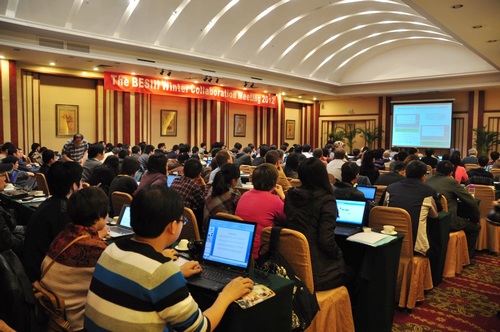BEPC & BEPCII
BESIII sets running targets for 2013
The BESIII Collaboration announced that it plans to accumulate about 500pb-1 data at 4.26GeV and 4.36GeV, respectively, in the
 |
| BESIII Collaboration meeting in winter, 2012 |
The data acquisition plans were discussed and decided at the BESIII Collaboration meeting, held in Guangxi Normal University from Nov. 25 to 29, 2012. More than 200 delegates from 50 collaborating institutes around the world attended the five-day-meeting.
Over the recent years, a series of new charmonium and charmonium-like particles (X, Y, and Z particles) have been discovered at B-Factories, i.e., BaBar Experiment at SLAC and Belle Experiment at KEK, via the B meson decays, the double-charmonia production, and the Initial State Radiation (ISR) processes. Some of the X, Y and Z particles can hardly be explained as conventional hadron states. Since the understanding of their nature and the study of their production and decay properties are hot topics in the current experiments, BESIII Collaboration hopes to provide solutions to the mysteries.
"The year of 2012 is a productive year for BEPCII/BESIII experiments. Till now, 28 papers have been submitted or published in the first-class international journals, and over 30 analysis papers are under the internal review before their final release to the public”, commented by Prof. SHEN Xiaoyan, Spokesperson of the BESIII Collaboration.
SHEN continued to introduce that with 225M J/psi and 106 M psi’ events accumulated at BESIII in 2009, the spin-parity of the abnormal threshold enhancement of proton and anti-proton is determined to be 0-+, which is crucial to the understanding of its nature. A strong isospin violation process has been observed, providing information for understanding the η(1440), a long-thought glueball candidate in the last decades.
The M2 transition process ψ'→γηc' has been observed at BESIII for the first time. The studies of ηc line-shape in ψ'→γηc transition and those of the interference effect have led to the most precise results on the mass and width of the ηc in the world.
At the meeting, reports covering BEPCII, BESIII software development and BESIII upgrade were also made. It was decided that the next collaboration meeting will be held at the institute of High Energy Physics in June, 2013.